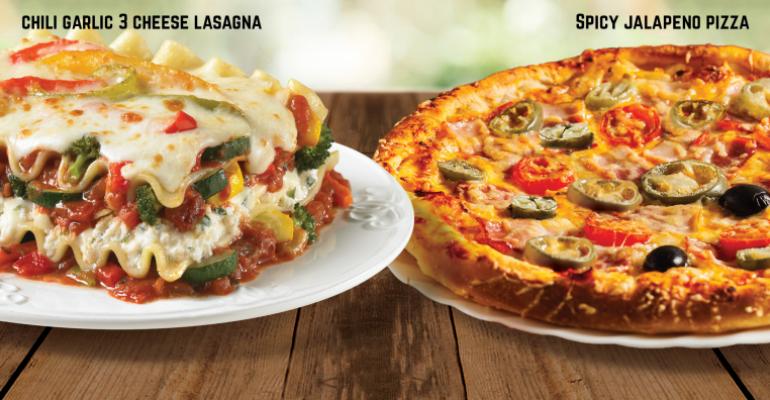Sponsored by Cholula Foodservice.
Mention the words “hot sauce” and many immediately think about its heat or the foods of Latin America that come alive with the addition of a robust chili pepper and vinegar concoction. That’s not so true anymore. Chefs across many segments of foodservice are recognizing the powerful flavors packed into chili pepper sauces. They are exploring their use in multiple cuisines, particularly in some unexpected areas like pizza and pasta sauces. Seeking to add just a little warmth with a lot of flavor, chefs are learning about the impact of chili pepper sauces on such dishes’ flavor — a broader dimension that grabs diners’ attention with the bold, vegetal notes of fermented peppers.
Those elements are what pizza maker Tony Gemignani wants from the hot sauces he sprinkles onto his pies, into his tomato sauces and onto his pasta dishes.
“I like a hot sauce that’s balanced, not too hot, not too salty or vinegary, just balanced,” says Gemignani, owner of multiple pizza concepts in San Francisco and Las Vegas, including the heralded Tony’s Pizza Napoletana. “People are looking for something spicy in their foods, but they don’t want a lot of heat. They want flavor.”
A 12-time pizza-making world champion (in baking and dough-throwing acrobatics), Gemignani’s first restaurant, Pyzano’s Pizzeria in Castro Valley, California, had bottles of Cholula® Original Hot Sauce on every table. Seeing how much customers liked it, he added it directly to a tomato-based sauce for a spicier profile on specific pies. Sales of the pizza took off.
“Man, that was a hit, a really good seller,” Gemignani recalls. “And so was the sauce as a condiment.”
At Pizza Rock, a three-unit, wood burning oven concept, one of his top sellers is the Picante. The tomato and mozzarella pie is topped with pepperoni, linguica, chorizo, garlic, Calabrese peppers, serrano peppers, banana peppers, scallions and finished with Cholula Hot Sauce.
“It’s a huge seller,” he says. “The pepper flavor of the whole pie is really milder than most people think. And I think that’s what they want.”
Research supports his hunch. A recent study conducted by Chicago-based Datassential showed that of the fastest growing sources of bolder flavors preferred by restaurant customers, the top two, sriracha and harissa, bear only mild heat. Not far behind were equally mild chili oil and paprika.
“A well made hot sauce”, Gemignani says, “is about flavor, not fire.”
“You can get fire if you want, but then you can’t taste your food,” he says. “If you want to see who’s pushing for those flavors, look at millennials and Hispanics.”
That makes the Mexican pizza at Mike’s Pizza ideally seasoned. The two-unit Sonora, California, pizzeria builds the pie with a mozzarella, provolone and cheddar cheese blend that’s layered with carnitas, fajita-style chicken, black olives, onions, jalapeño slices and a dash of hot sauce.
“That pizza gets some Cholula splashed on it just before it goes in the oven,” says owner Jim Simonitch. “The heat from that 480 degree Fahrenheit oven creates a really nice aroma. It’s not surprising that this pizza’s really popular.”
Simonitch has tried several other hot sauces, but found them either too vinegary or peppery or both. He chose Cholula Original “because it’s balanced, has good flavor with a pleasant heat that excites but doesn’t overwhelm. I also consider the aroma to be a more authentic Mexican aroma. You don’t just smell vinegar.”
At PaPPo’s Pizzeria & Pub in Springfield, Missouri, a Cholula chicken topping is one of many options guests can choose to customize their pizza. According to kitchen manager Frank Cumby, grilled chicken is tossed into the hot sauce and placed on the pizza before baking.
“One of the reasons why we use Cholula is because it coats better than other hot sauces we’ve tried,” Cumby says. “It caramelizes well in the oven and doesn’t come out as spicy as some that we’ve used. We’ve tried a lot of others, but this is the one we like.”
Pizza isn’t the only item on Gemignani’s menu that gets its zing from hot sauce. He said it works really well in pasta using either a spicy tomato sauce or a few dashes as final seasoning when it leaves the kitchen.
“I’ve used it on our bucatini before, drizzling on a little bit right at the line,” he says. Acknowledging that pepper sauce flavor will intensify with heating, Gemignani advises under-seasoning at first.
“If you’re going to add it directly to the sauce, you’ve got to be careful to incorporate the right amount,” he says. “There’s no backing out once it’s in.”
A classically trained pizza maker, Gemignani acknowledges that some of his Italian teachers might frown on the use of pepper sauce on their country’s beloved pizza and pasta standards. But as menus at his multiple concepts demonstrate, he’s not afraid to experiment, and he encourages his consulting clients to do the same.
“People have a well established idea of what pizza and pasta are supposed to taste like, so be different and give them something new to taste,” he says. He advises chefs to view chili pepper sauce as they would salt or pepper — as a basic seasoning, not even a source of heat. “When you see it that way, you can experiment with it however you like: in sauces, in dressings, on meat, on whatever,” he says. “It’s versatile, so be creative with it.”





